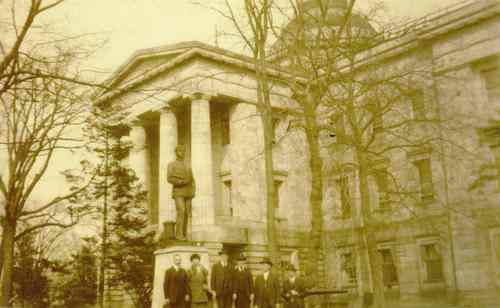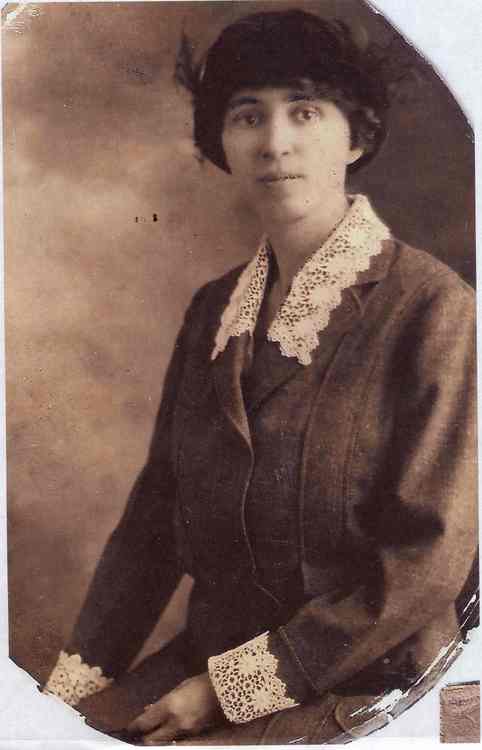
by Anne Chesky Smith
The results of the July 3, 1920 Buncombe County Democratic primary were not just a victory for Lillian Exum Clement, but for thousands of women across North Carolina who had been fighting for women’s suffrage. Months before the 19th Amendment was ratified on August 26, 1920, Lillian Exum Clement, a young lawyer from Black Mountain, North Carolina, was chosen by the men in the Democratic party of Buncombe County as the first female candidate for the North Carolina legislature.Lillian, or Exum as she was often know by her friends and family, would go on to crush her male Independent party opponent in the November general election by an astounding 10,368 votes to 41 and become the first female legislator in the South.But before she became a politician, before she was the first female to open her own law practice in North Carolina, and before she began working in the Buncombe County Sheriff’s Office, Lillian Exum Clement played, studied, and lived in the North Fork Valley, just outside of Black Mountain.
On an early spring day, in March of 1884*, Lillian became the third child to be born to George Washington and Sarah Elizabeth Burnett Clement. George Washington Clement (1852 – 1942) came to the North Fork Valley with the railroad after Civil War skirmishes destroyed his plantation in Charleston, South Carolina. During his travels through the valley, he met Sarah Elizabeth, daughter of long-time North Fork residents, Alfred and Nancy Burnett. Sarah Elizabeth had been widowed during the war and it was love at first sight. After their first meeting, he told his traveling companions, “I’m going to marry her.”
And in the fall of 1878, George and Sarah were married. Their first child was born in 16 months later.
Lillian and her siblings attended the one-room school house on the North Fork of the Swannanoa River. Most likely, Lillian would have attended the second North Fork schoolhouse. The second school house replaced Stepp’s School House in about 1870 and educated most of the children in the valley until around 1910 when the third schoolhouse was constructed. This schoolhouse was known as the “school between the creeks,” because it was built on an island created by a parting of the river. All three schoolhouse sites would be covered with water when the City of Asheville dammed the river to create its reservoir.
In 1907, her father was hired by George Vanderbilt to work at the Biltmore Estate about 20-miles away in Asheville. The 250-room, 125,000-acre estate required a village to run, and so George Vanderbilt had one constructed.
Vanderbilt purchased the small town known as Best, leveled it, and rebuilt a new town (now known as Biltmore Village) for his employees that included English-style cottages as well as a hospital, church, and school. In was in the village’s church that Lillian was confirmed into the Christian faith and from the village’s All Soul’s Parish School that she graduated.
Though as a woman she could not attend law school, George Vanderbilt’s wife, Edith, encouraged Lillian to pursue her dream to become a lawyer and Lillian studied for her bar exam under two prominent lawyers. On February 17, 1916, she passed her exam and earned a prize for having one of the top grades.
Almost a year later, Lillian hung a shingle embossed with her name outside her new law offices in Asheville, thus becoming the first women in North Carolina to practice law unsupported by male colleagues. Less than two months later she won her first case.
After serving as a practicing lawyer for over three years, she made her formal announcement as a candidate for the North Carolina House of Representatives on April 15, 1920, won, and was sworn in as the first female legislator in the South on January 5, 1921.
She was described by an article dated ten days later in the Greensboro Daily News as, “small in stature, modest and retiring in manner, unassuming but keenly alert to situations requiring clearness of thought, she is all that the most exacting would demand…. She wears a Norfolk jacket of green tweed with a small velvet hat, and in her modest attire is a little conspicuous as any other member of the house.”
She introduced 17 bills during her tenure – 16 of which became law, including a bill that allowed women abandoned by their husbands to get a divorce after five years rather than ten, another that called for private voting booths and secret ballots, and still another that required that dairy cattle be tested for tuberculin. Though Exum faced opposition – once her nose was broken by an irate man and on another occasion a crowd pelted with eggs and rotten vegetables – she was generally beloved by her fellow North Carolinians.
After serving a little over two months in office, she married Elias Eller Stafford, a reporter for the Asheville Citizen, on March 8, 1921. She did not run for a second term, but continued to be active as a lawyer and an advocate for women.

Two years later, in May 1923, she gave birth to a premature baby girl – Asheville’s first incubator baby –who she named Nancy after her sister. For the next year and a half, while suffering from long bouts of illness, Exum kept a diary that chronicled her love for the child and each milestone the young girl achieved. She would often bundle Nancy up to make the journey from Asheville to Black Mountain so they could spend the day with the Clements in North Fork.
The final entry in Exum’s diary reads, “Last night you slept with someone besides Daddy and Mother for the first time. Daddy was sick and Mother was sick and Aunt Nancy came in and spent the night with you.” Twelve days later, Exum passed away from complications of pneumonia, leaving her daughter to be raised by her godmother and namesake, Aunt Nancy.
Just shy of 41 when she died, quiet, dignified Lillian Exum Clement was able to lead the way for the many women that would serve after her. Her eulogy in the Asheville Citizen read, “A daughter of the present age, she held to the best of the old days while adopting the best of the new.”
This story was written using materials collected at the Swannanoa Valley Museum. The museum will feature Lillian Exum Clement in their 2013 exhibit, “Heart of the Valley: The People Who Made Us Who We Are,” a preview of which was featured in the 2012 Black Mountain Christmas Parade museum float.
*Most contemporary sources report her birth date as 1894, but the 1900 and 1910 census list her as being born in 1884. Though she listed her birth date at 1894 on her marriage certificate, which is where her birth date is often taken from, she may have “fudged the number” because her husband was born in 1895. It would have seemed odd for a woman to marry a man 10 years her junior at this time.